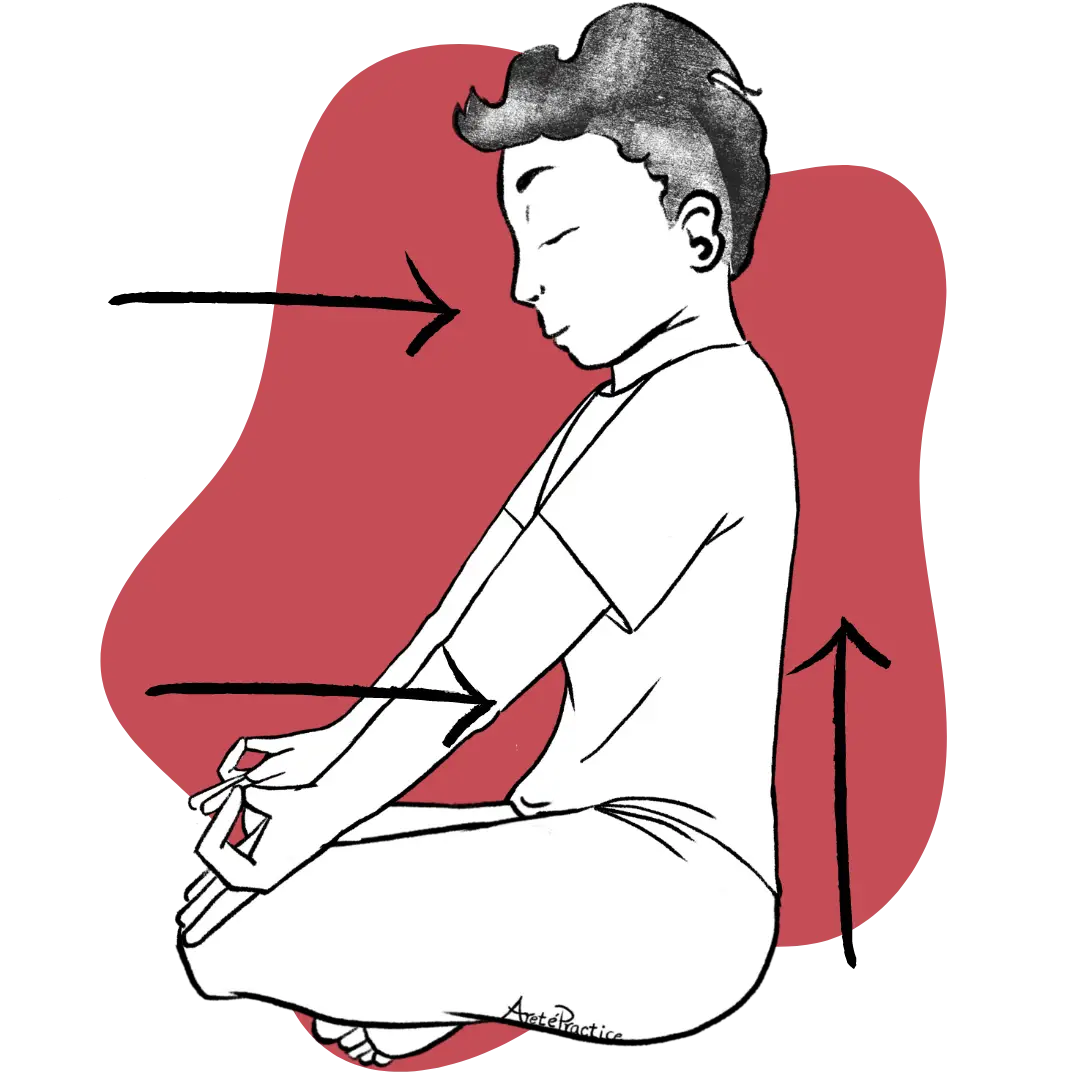Knot of Brahman
The first energetic knot in the subtle body, located at the base of the spine, associated with the root chakra (Muladhara). It represents obstacles related to physical survival and primal instincts.
The first energetic knot in the subtle body, located at the base of the spine, associated with the root chakra (Muladhara). It represents obstacles related to physical survival and primal instincts.
The third energetic knot, located at the area of the third eye, associated with the third eye chakra (Ajna). It represents mental and intellectual blockages and the challenge of overcoming illusion and duality to achieve higher consciousness.
The second energetic knot, located at the heart center, associated with the heart chakra (Anahata). It represents emotional attachments and difficulties in transcending ego and desires.
Kosha is a Sanskrit term meaning “sheath” or “layer.” In yoga philosophy, koshas refer to the five layers of the human being, each representing different aspects of existence from the physical to the spiritual. These layers are believed to surround the true self or Atman, and include the physical body (Annamaya Kosha), the energetic body (Pranamaya Kosha), the mental body (Manomaya Kosha), the wisdom body (Vijnanamaya Kosha), and the bliss body (Anandamaya Kosha). The understanding of koshas helps practitioners realize the holistic nature of the self and guides them towards self-realization and spiritual growth.
Ksepana Mudra, the Gesture of Release, targets the heart and sacral chakras, as well as the air and water elements. This mudra helps expel negativity, stress, and tension, promoting emotional cleansing and balance. By practicing Ksepana Mudra, you can create space for positivity and rejuvenation, leading to a lighter and clearer state of being.

Kundalini is a Sanskrit term that refers to the dormant spiritual energy believed to be coiled at the base of the spine. In yoga and tantra traditions, Kundalini is seen as a potential force that, when awakened, rises through the energy centers or chakras along the spine, leading to spiritual enlightenment. The awakening of Kundalini is said to result in a profound transformation of consciousness, unlocking higher states of awareness, creativity, and spiritual insight. The practice of Kundalini yoga aims to awaken and channel this powerful energy through various techniques such as asana, pranayama, mantra, and meditation.
Kundalini surjhee satsangat,
paramanand guru mukh macha.
Jinho baat nischal dhru jaanee,
tayee jeev kaal tay bacha.
Tin tario samundar rudar khin ek meh,
jalahar bimb jugat jag rachaa.
Siri guru sahib sabh upaar,
man bach karam sayveeai sacha
Those who realize the Eternal, Unchanging Word of God, like Dhroo, are immune to death.
They cross over the terrifying world-ocean in an instant; the Lord created the world like a bubble of water.
The Kundalini rises in the Sat Sangat, the True Congregation; through the Word of the Guru, they enjoy the Lord of Supreme Bliss.
The Supreme Guru is the Lord and Master over all; so serve the True Guru, in thought, word and deed.
Kundalini Surjhee shabd is from the scripts of Guru Ram Das. This recitation gives the practitioner an understanding of the flow of the Kundalini Energy and has a rejuvenating effect on the body through toning the inner organs.
Laya Yoga is a form of yoga that focuses on the dissolution or merging of individual consciousness with the universal consciousness. It emphasizes the awakening and ascent of Kundalini energy through the chakras, leading to spiritual enlightenment. Laya Yoga involves practices such as mantra chanting, meditation, visualization, and breath control to awaken and raise the Kundalini energy from its dormant state at the base of the spine to the crown chakra at the top of the head. The goal of Laya Yoga is to transcend the limitations of the individual ego and experience oneness with the divine.
Lotus Mudra can also be called Padma Mudra or Pankaj Mudra in Sanskrit. Practicing Lotus Mudra opens and balances the Heart Center (Anahata Chakra) and evokes qualities of compassion, forgiveness, affection, and loving-kindness. It can also help create overall positivity.
The lotus flower has often been depicted in the hands and heart centers of Gods and adepts from many traditions. This flower symbolizes the perfection and beauty that comes out of suffering, just as the lotus starts to grow in muddy waters but rises up out of it to bloom beautifully. As such, this mudra also symbolizes the blooming we can experience as we rise up from our circumstances and progress on our spiritual path. It represents purity, growth, and connection to spirit.
Maha Bandah, also known as The Great Lock, is created when you apply simultaneously Mula Bandha, Uddiyana Bandha, and Jalandhara Bandha. Maha bandha is central to Kundalini Yoga as its main purpose is to awaken Kundalini Energy. This is done by uniting Prana Vayu with Apana Vayu, and sparking the awakening of the Kundalini Energy which is then forced to move up the Sushumna Channel and activate the seven chakras.

Head over to our Deep Dive article on Maha Bandha to learn how to practice this technique safely.
Om Tri-ambakham Yaajaa Mahay
Sugandheem Pushteevaadhaanan
Oorvaarookamiv Bandhanaat
Mrityor Mukhshee-aa Maamrootaat
Om, we worship the tri-ambakham (the three-eyed one)
Who is fragrant (as the spiritual essence), increasing the nourishment (of our spiritual core)
From these many bondages (of samsara) like cucumbers (attached to their vines)
May I be liberated from death (attachment to perishable things) so that I am not separated from the perception of immortality (immortal essence pervading everywhere)
This mantra helps us prepare to face death by knowing that who we really are cannot die, but just leaves the physical body. It strengthens the mind and nervous system to get ready for the coming age, so we can help others along the way. It develops purity in us.
A string of prayer beads used to count repetitions of mantras or prayers.
Manas is a Sanskrit term that refers to the aspect of the mind responsible for processing sensory information and forming thoughts and perceptions. It is often translated as “mind” and is considered one of the four aspects of the inner instrument (Antahkarana) in yoga philosophy, along with Buddhi (intellect), Chitta (mind stuff), and Ahamkara (ego). Manas is associated with the sense of sight and is considered the seat of emotions and desires. It plays a crucial role in the functioning of the mind and is central to the practice of yoga, which aims to control and transcend its fluctuations to attain a state of inner peace and clarity.
Manipura is the third primary chakra, located at the solar plexus region of the body. Its name translates to “lustrous gem” in Sanskrit, symbolizing its qualities of personal power, vitality, and transformation. Manipura is associated with the element of fire and is believed to govern aspects of self-esteem, willpower, and digestion. Balancing Manipura is thought to result in a sense of confidence, self-control, and the ability to pursue one’s goals with clarity and determination.
Manomaya Kosha is a concept in yoga philosophy that refers to the mental sheath or layer of the human being, according to the Pancha Kosha (five sheaths) model. It is considered the second outermost layer, surrounding the physical body (Annamaya Kosha), and is associated with the mind, emotions, and sensory perceptions. Manomaya Kosha is where thoughts, feelings, and memories are processed and experienced. This sheath is believed to be made up of the subtle elements of the mind (manas) and is responsible for the functioning of the lower mind. In the practice of yoga, understanding and working with the Manomaya Kosha can lead to a deeper understanding of the mind and its influence on our experiences and behaviors.
Mantra refers to a sacred word, sound, or phrase repeated or chanted during meditation or spiritual practice. Mantras are believed to have inherent power and are used as a tool to focus the mind, cultivate specific qualities or intentions, and connect with the divine. They can be simple sounds, syllables, or phrases with deep spiritual significance, and their repetition is believed to create a vibration that aligns the individual with higher consciousness.